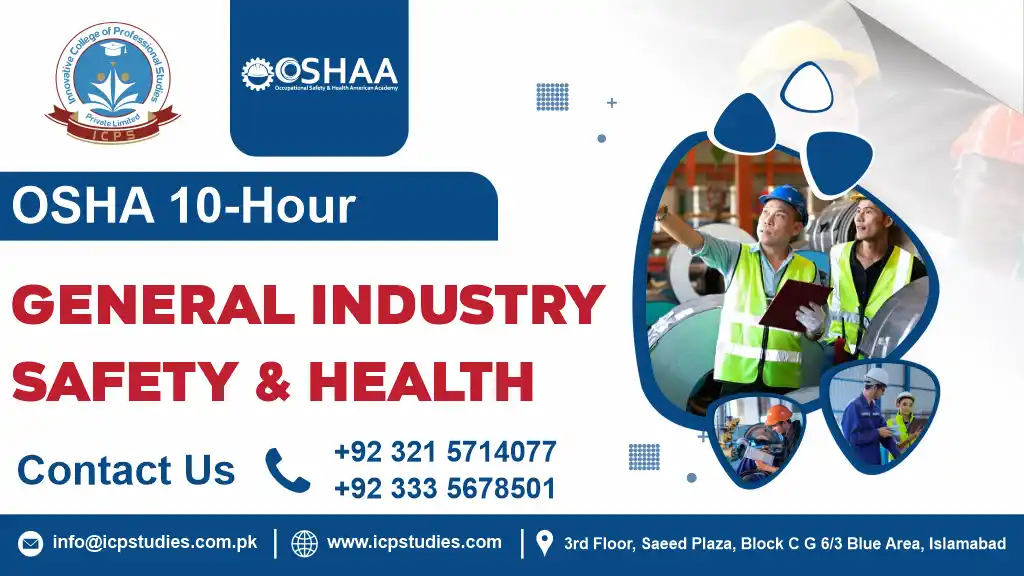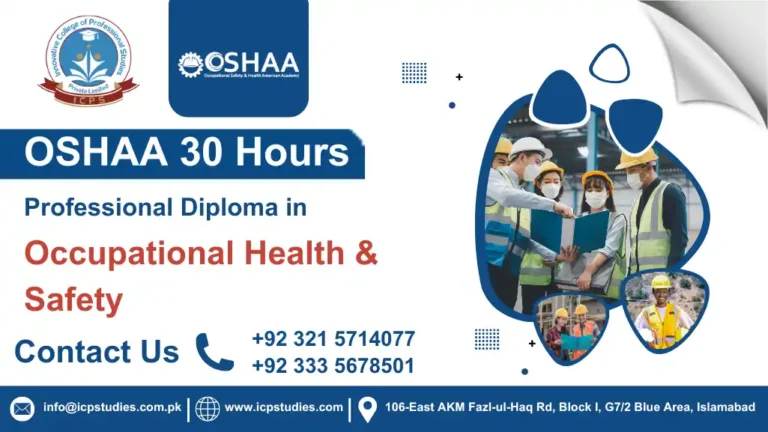In today’s fast-paced work environments, ensuring workplace safety is more crucial than ever. One of the fundamental ways to achieve this is through education and training. The OSHA 10-Hour General Industry Safety and Health course stands out as a valuable resource for both employers and employees aiming to enhance safety awareness and compliance.
The OSHA 10-Hour General Industry Safety and Health course is an entry-level training program designed to provide workers with a basic understanding of safety and health regulations and best practices in general industry settings. This course, administered by the Occupational Safety and Health Administration (OSHA), covers essential safety topics and helps workers recognize and mitigate potential hazards in the workplace.
The OSHA 10-Hour General Industry Safety and Health course is an essential training program that provides a solid foundation in workplace safety and health. By covering key safety topics and OSHA regulations, the course helps participants recognize hazards, improve compliance, and contribute to a safer work environment. Whether you are a new employee, a supervisor, or a safety professional, this course offers valuable knowledge and skills that can enhance workplace safety and support career development. Investing in this training is a proactive step towards creating a safer, more compliant, and productive workplace.
All About OSHA 10-Hour General Industry Safety and Health
Course Overview
The OSHA 10-Hour General Industry Safety and Health course is an introductory training program designed by the Occupational Safety and Health Administration (OSHA) to provide employees with a fundamental understanding of workplace safety and health principles. Aimed at workers in a variety of general industry sectors, this course covers essential safety practices and OSHA regulations to help create safer working environments and reduce the risk of workplace accidents.
The OSHA 10-Hour General Industry Safety and Health course is a valuable training program designed to provide workers with essential knowledge about workplace safety and health. It covers fundamental safety practices and OSHA regulations, aiming to enhance safety awareness, ensure compliance, and promote a safer working environment. Whether you’re a new employee, a supervisor, or a safety coordinator, this course provides critical insights that can help prevent workplace accidents and contribute to overall safety and health in general industry settings.
Study Units
- Introduction to OSHA
- Walking and Working Surfaces
- Exit Routes, Emergency Action Plans, and Fire Prevention Plans
- Electrical Safety
- Personal Protective Equipment (PPE)
- Hazard Communication
- Machine Guarding
- Industrial Hygiene
- Ergonomics
- Bloodborne Pathogens
- Introduction to Industrial Safety
- Safety and Health Programs
- Material Handling and Storage
- Lockout/Tagout
- Fall Protection
- Confined Spaces
- Respiratory Protection
- Fire Safety
- Introduction to OSHA Standards
To enroll in the OSHA 10-Hour General Industry Safety and Health course, participants typically need to meet the following requirements:
- Age Requirement: Participants should be at least 18 years old.
- Basic Literacy: A good understanding of English is important, as course materials and instruction are primarily in English.
- Job Relevance: While not mandatory, it is beneficial for participants to work in or be involved with general industry settings.
- No Formal Prerequisites: There are generally no prerequisites for this course, although some familiarity with workplace safety concepts can be helpful.
- Course Registration: Participants must register for the course through an authorized training provider.
- Payment: Course fees must be paid as required by the training provider.
- Commitment to Attend: Participants should be prepared to attend the full duration of the course (10 hours) to receive certification.
Always check with the specific training provider for any additional or varying requirements.
The OSHA 10-Hour General Industry Safety and Health course is designed for:
- General Industry Workers: Employees across various sectors seeking foundational safety training.
- Supervisors and Foremen: Individuals overseeing teams who need to understand safety regulations and practices.
- New Employees: Those entering the workforce in general industry who require basic safety awareness.
- Safety Coordinators: Professionals responsible for implementing safety measures and promoting a culture of safety.
- Contractors and Subcontractors: Workers involved in projects within general industry settings.
- Health and Safety Committee Members: Employees engaged in workplace safety initiatives.
This course equips participants with essential knowledge about hazard recognition, safety practices, and regulatory compliance relevant to general industry, helping to foster a safer work environment.
Learning Outcome
Introduction to OSHA
- Learning Outcome: Understand the purpose, structure, and functions of OSHA, including the agency’s role in regulating workplace safety and health. Recognize the rights and responsibilities of employers and employees under OSHA standards and how OSHA regulations are enforced.
2. Walking and Working Surfaces
- Learning Outcome: Identify and assess hazards associated with walking and working surfaces. Learn to implement control measures to prevent falls and injuries related to slips, trips, and falls in the workplace.
3. Exit Routes, Emergency Action Plans, and Fire Prevention Plans
- Learning Outcome: Develop and implement effective exit routes and emergency action plans. Understand fire prevention strategies and how to create and maintain a fire prevention plan to protect employees in case of emergencies.
4. Electrical Safety
- Learning Outcome: Understand the basic principles of electrical safety, including the identification of electrical hazards and safe practices for working with electrical systems and equipment. Learn to implement safety measures to prevent electrical accidents.
5. Personal Protective Equipment (PPE)
- Learning Outcome: Identify different types of PPE, their applications, and the proper procedures for selecting, using, and maintaining PPE. Ensure that PPE is appropriately used to protect workers from various hazards.
6. Hazard Communication
- Learning Outcome: Understand OSHA’s Hazard Communication Standard, including how to read and interpret labels and Safety Data Sheets (SDS). Learn to communicate hazard information effectively to employees and ensure compliance with labeling and safety data requirements.
7. Machine Guarding
- Learning Outcome: Recognize the importance of machine guarding in preventing injuries. Learn to identify machine hazards and implement effective guarding techniques to protect workers from moving parts and other machine-related dangers.
8. Industrial Hygiene
- Learning Outcome: Understand the principles of industrial hygiene, including how to identify and control workplace exposures to harmful substances. Learn methods for conducting exposure assessments and implementing controls to protect employee health.
9. Ergonomics
- Learning Outcome: Apply ergonomic principles to workplace design and task performance. Learn to identify ergonomic risks and implement strategies to reduce physical strain and enhance employee comfort and productivity.
10. Bloodborne Pathogens
- Learning Outcome: Recognize the risks associated with bloodborne pathogens and understand the procedures for minimizing exposure. Learn to implement control measures and personal protective practices to prevent transmission of bloodborne diseases.
11. Introduction to Industrial Safety
- Learning Outcome: Gain a foundational understanding of industrial safety concepts and practices. Learn about the role of safety management and the importance of integrating safety into daily operations and organizational culture.
12. Safety and Health Programs
- Learning Outcome: Understand the components of effective safety and health programs, including policy development, risk assessment, and employee involvement. Learn to create and implement programs that improve safety and health outcomes in the workplace.
13. Material Handling and Storage
- Learning Outcome: Learn best practices for the safe handling and storage of materials. Understand techniques for preventing injuries related to lifting, moving, and storing materials, and implement strategies to ensure safe material handling procedures.
14. Lockout/Tagout
- Learning Outcome: Understand the principles and procedures of lockout/tagout to control hazardous energy during maintenance and repair activities. Learn to implement lockout/tagout programs to prevent accidental machine start-ups and ensure worker safety.
15. Fall Protection
- Learning Outcome: Recognize fall hazards and understand the requirements for fall protection in various workplace scenarios. Learn to implement fall protection measures and select appropriate equipment to prevent fall-related injuries.
16. Confined Spaces
- Learning Outcome: Understand the hazards associated with confined spaces and the requirements for safe entry and work in these environments. Learn to identify confined space hazards and develop procedures to ensure safety during confined space operations.
17. Respiratory Protection
- Learning Outcome: Understand the principles of respiratory protection, including how to select, use, and maintain respirators. Learn to assess respiratory hazards and implement effective respiratory protection programs to safeguard worker health.
18. Fire Safety
- Learning Outcome: Learn about fire safety principles, including fire prevention, detection, and response. Understand how to develop and implement fire safety plans and conduct fire drills to prepare for emergencies.
19. Introduction to OSHA Standards
- Learning Outcome: Gain an overview of key OSHA standards applicable to general industry. Understand the regulatory requirements and how to apply these standards to ensure workplace safety and health compliance.
By mastering these learning outcomes, participants in the OSHA 10-Hour General Industry Safety and Health course will be well-equipped to recognize, assess, and mitigate workplace hazards, thereby contributing to a safer and more compliant work environment.
FAQs about OSHA 10-Hour General Industry Safety and Health







